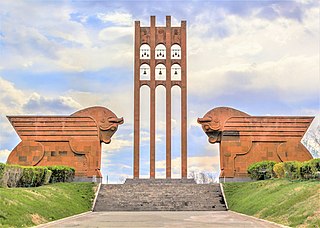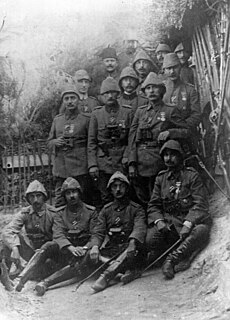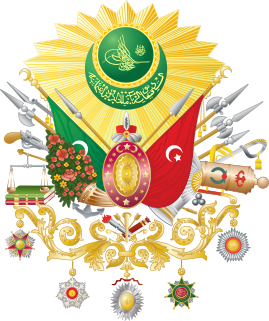
The Battle of Sarikamish was an engagement between the Russian and Ottoman empires during World War I. It took place from December 22, 1914, to January 17, 1915, as part of the Caucasus Campaign.

The Erzurum offensive or Battle of Erzurum was a major winter offensive by the Imperial Russian Army on the Caucasus Campaign, during the First World War that led to the capture of the strategic city of Erzurum.

The Battle of Sardarabad was a battle of the Caucasus campaign of World War I that took place near Sardarabad, Armenia, from 21 to 29 May 1918, between the regular Armenian military units and militia on one side and the Ottoman army that had invaded Eastern Armenia on the other. As Sardarabad is approximately 40 kilometres (25 mi) west of the capital of Yerevan, the battle not only halted the Ottoman advance into the rest of Armenia, but also prevented the complete destruction of the Armenian nation. In the words of Christopher J. Walker, had the Armenians lost this battle, "it is perfectly possible that the word Armenia would have henceforth denoted only an antique geographical term".

The Caucasus campaign comprised armed conflicts between the Russian Empire and the Ottoman Empire, later including Armenia, Azerbaijan, Georgia, the Mountainous Republic of the Northern Caucasus, the German Empire, the Central Caspian Dictatorship, and the British Empire, as part of the Middle Eastern theatre during World War I. The Caucasus campaign extended from the South Caucasus to the Armenian Highlands region, reaching as far as Trabzon, Bitlis, Mush and Van. The land warfare was accompanied by naval engagements in the Black Sea.

Ahmed Izzet Pasha, known as Ahmet İzzet Furgaç after the Turkish Surname Law of 1934, was an Ottoman general during World War I. He was also one of the last Grand Viziers of the Ottoman Empire and its last Minister of Foreign Affairs.

The Battle of Koprukoy was part of the Caucasus Campaign during World War I between the Russian Empire and the Ottoman Empire, and occurred as the Russians were advancing to Erzurum. The Russians achieved total surprise and broke through the Ottoman defenses, sending the Third Army retreating towards Erzurum.
The Second Army of the Ottoman Empire was one of the field armies of the Ottoman Army. It was formed in the late 19th century during Ottoman military reforms.

The Bergmann Offensive was the first engagement of the Caucasus Campaign during World War I. General Georgy Bergmann, commander of I Caucasian Army Corps, took the initiative against the Ottoman Empire.

Christophor Araratov, also known as Khachatur Araratian and Kristapor Araratian, was a career officer of the Russian Imperial Army. He was promoted to the rank of Major General of the Armenian army during its fight for independence during and after World War I. Araratov participated in the 1918 battles of Sardarapat and Karakilisa against Turkish invaders.

Mahmud Kâmil Pasha was a general of the Ottoman Army. He was born in Heleb (Aleppo) and died in Constantinople (Istanbul).

The Battle of Erzurum was a military engagement fought between the Ottoman Empire and the Russian Empire, during the Russo-Turkish War of 1877-1878. The battle was fought on 8-9 November 1877 on the Ottoman territory and ended with the Russians withdrawing to instead besiege Kars, which fell afterwards.
The First Army or First Guards Army of the Ottoman Empire was one of the field armies of the Ottoman Army. It was formed in the middle 19th century during Ottoman military reforms.

The III Corps of the Ottoman Empire was one of the corps of the Ottoman Army. It was formed in the early 20th century during Ottoman military reforms.
The X Corps of the Ottoman Empire was one of the corps of the Ottoman Army. It was formed in the early 20th century during Ottoman military reforms.

The Fourth Army of the Ottoman Empire was one of the field armies of the Ottoman Army. It was formed in the middle nineteenth century, during Ottoman military reforms.

The Sixth Army of the Ottoman Empire was one of the field armies of the Ottoman Army. It was formed in the middle 19th century during Ottoman military reforms.
The Chataldja Army or Çatalca Army of the Ottoman Empire was one of the field armies of the Ottoman Army. It was formed after Ottoman retreat to the Chataldja line during the First Balkan War. It confronted Bulgarian forces. It was organized from units of dissolved First Eastern Army and Second Eastern Army on November 7, 1912.
The Eastern Front was one of the fronts of the Army of the Grand National Assembly during the Turkish War of Independence. Its commanded all military units in Eastern Region. At first, its headquarters was located at Erzurum, and moved to Sarıkamış, then Kars during the Turkish–Armenian War.

The Ottoman Army was reorganized along modern Western European lines during the Tanzimat modernization period and functioned during the decline and dissolution period that is roughly between 1861 and 1918, end of World War I for the Ottomans. The last reorganization occurred during the Second Constitutional Era.

The Battle of Goychay or Raid on Goychay, was a series of clashes that took place from 27 June to 1 July 1918, between Ottoman–Azerbaijani coalition forces led by Nuri Pasha and a coalition of the Soviet 11th Army and Armenian Dashnak forces. The initial battle ended on 30 June, but minor clashes continued until 1 July. Despite being outnumbered six to one, the Central Powers were able to defeat the Armenian–Soviet forces before they reached Ganja, the headquarters of the Ottoman Islamic Army of the Caucasus. The Ottoman–Azerbaijani forces seized control of the lands from Goychay to Shamakhi. Armenian–Soviet rule in the region ended as a result of the battle.














